New Advances in Site Investigations and In-Situ Testing and Monitoring
VerifiedAdded on 2020/11/23
|26
|9676
|214
Report
AI Summary
This report provides an overview of advancements in site investigation techniques, focusing on in-situ testing and monitoring methods. It discusses various techniques, including the Standard Penetration Test (SPT), Cone Penetration Testing (CPT), field vane shear testing, dilatometer testing (DMT), and full flow penetrometers. The report delves into the principles, applications, and advantages/disadvantages of each method, along with correction techniques and factors affecting results. A case study of peat and a site in Bursa, Turkey, are presented to illustrate the practical implementation of these techniques. The report highlights the importance of site investigation in analyzing potential hazards and assessing soil properties for infrastructure development, emphasizing the evolution of data acquisition and the significance of in-situ tools. The report aims to provide a comprehensive understanding of the current landscape of site investigation and in-situ testing methods.
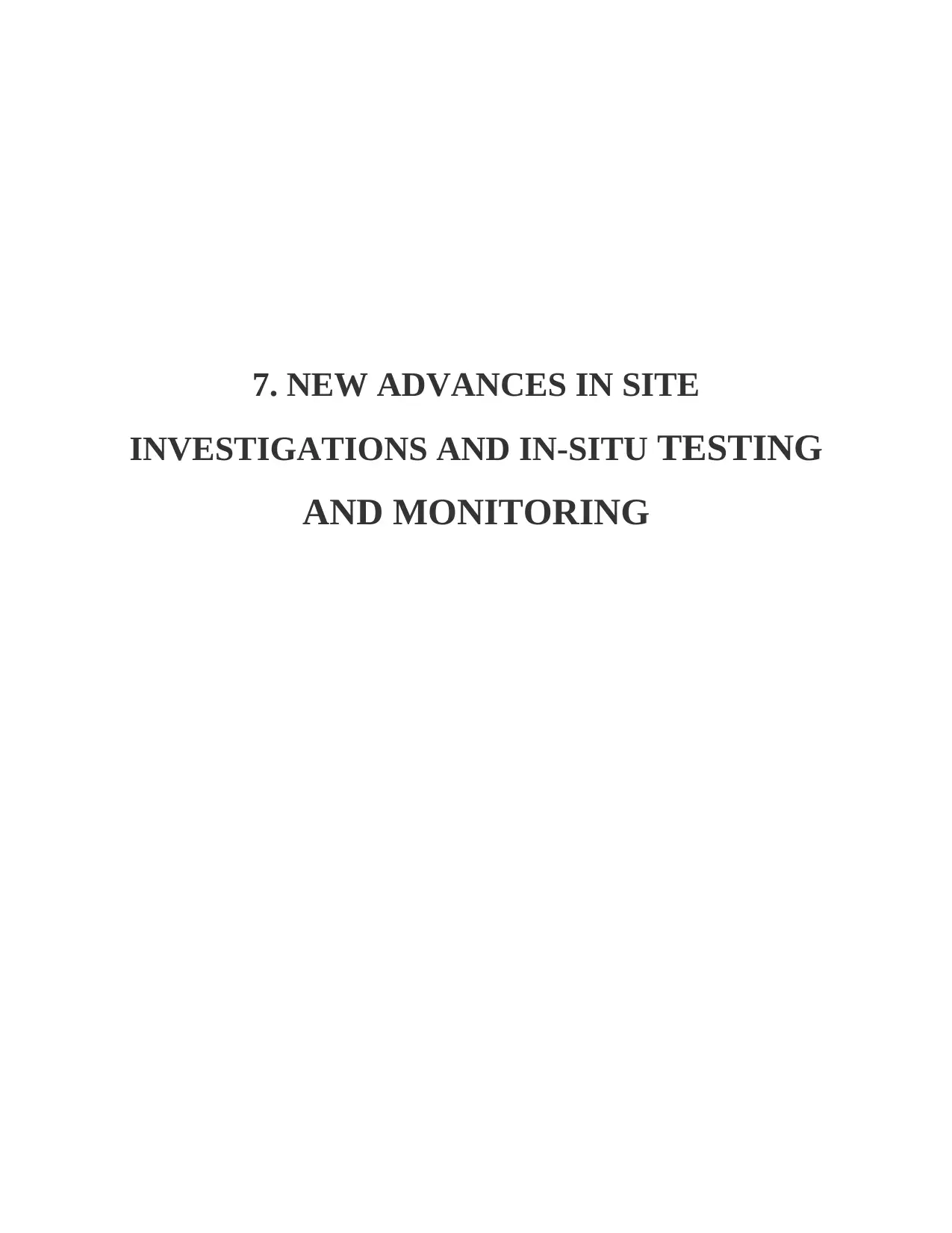
7. NEW ADVANCES IN SITE
INVESTIGATIONS AND IN-SITU TESTING
AND MONITORING
INVESTIGATIONS AND IN-SITU TESTING
AND MONITORING
Paraphrase This Document
Need a fresh take? Get an instant paraphrase of this document with our AI Paraphraser
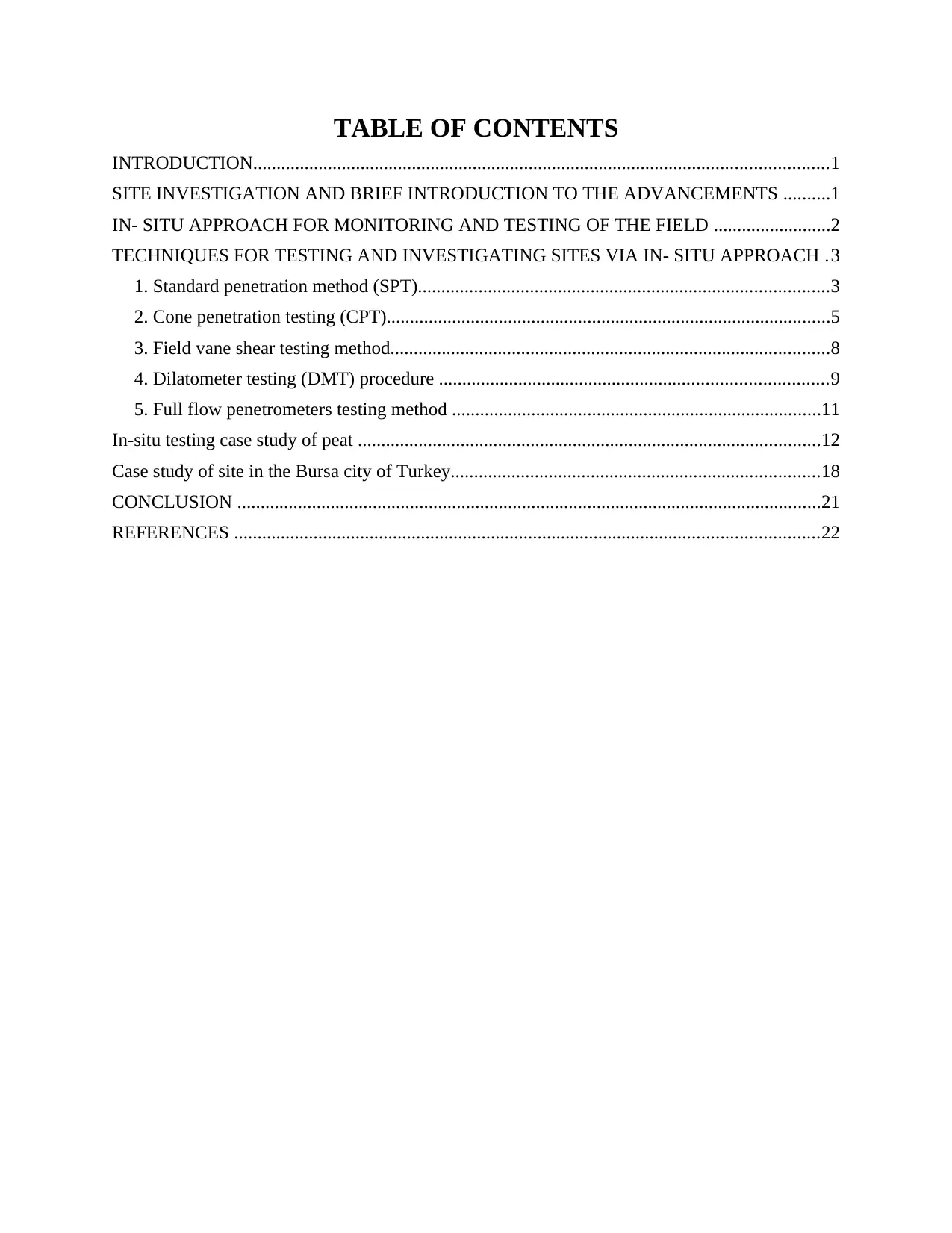
TABLE OF CONTENTS
INTRODUCTION...........................................................................................................................1
SITE INVESTIGATION AND BRIEF INTRODUCTION TO THE ADVANCEMENTS ..........1
IN- SITU APPROACH FOR MONITORING AND TESTING OF THE FIELD .........................2
TECHNIQUES FOR TESTING AND INVESTIGATING SITES VIA IN- SITU APPROACH .3
1. Standard penetration method (SPT)........................................................................................3
2. Cone penetration testing (CPT)...............................................................................................5
3. Field vane shear testing method..............................................................................................8
4. Dilatometer testing (DMT) procedure ...................................................................................9
5. Full flow penetrometers testing method ...............................................................................11
In-situ testing case study of peat ...................................................................................................12
Case study of site in the Bursa city of Turkey...............................................................................18
CONCLUSION .............................................................................................................................21
REFERENCES .............................................................................................................................22
INTRODUCTION...........................................................................................................................1
SITE INVESTIGATION AND BRIEF INTRODUCTION TO THE ADVANCEMENTS ..........1
IN- SITU APPROACH FOR MONITORING AND TESTING OF THE FIELD .........................2
TECHNIQUES FOR TESTING AND INVESTIGATING SITES VIA IN- SITU APPROACH .3
1. Standard penetration method (SPT)........................................................................................3
2. Cone penetration testing (CPT)...............................................................................................5
3. Field vane shear testing method..............................................................................................8
4. Dilatometer testing (DMT) procedure ...................................................................................9
5. Full flow penetrometers testing method ...............................................................................11
In-situ testing case study of peat ...................................................................................................12
Case study of site in the Bursa city of Turkey...............................................................................18
CONCLUSION .............................................................................................................................21
REFERENCES .............................................................................................................................22
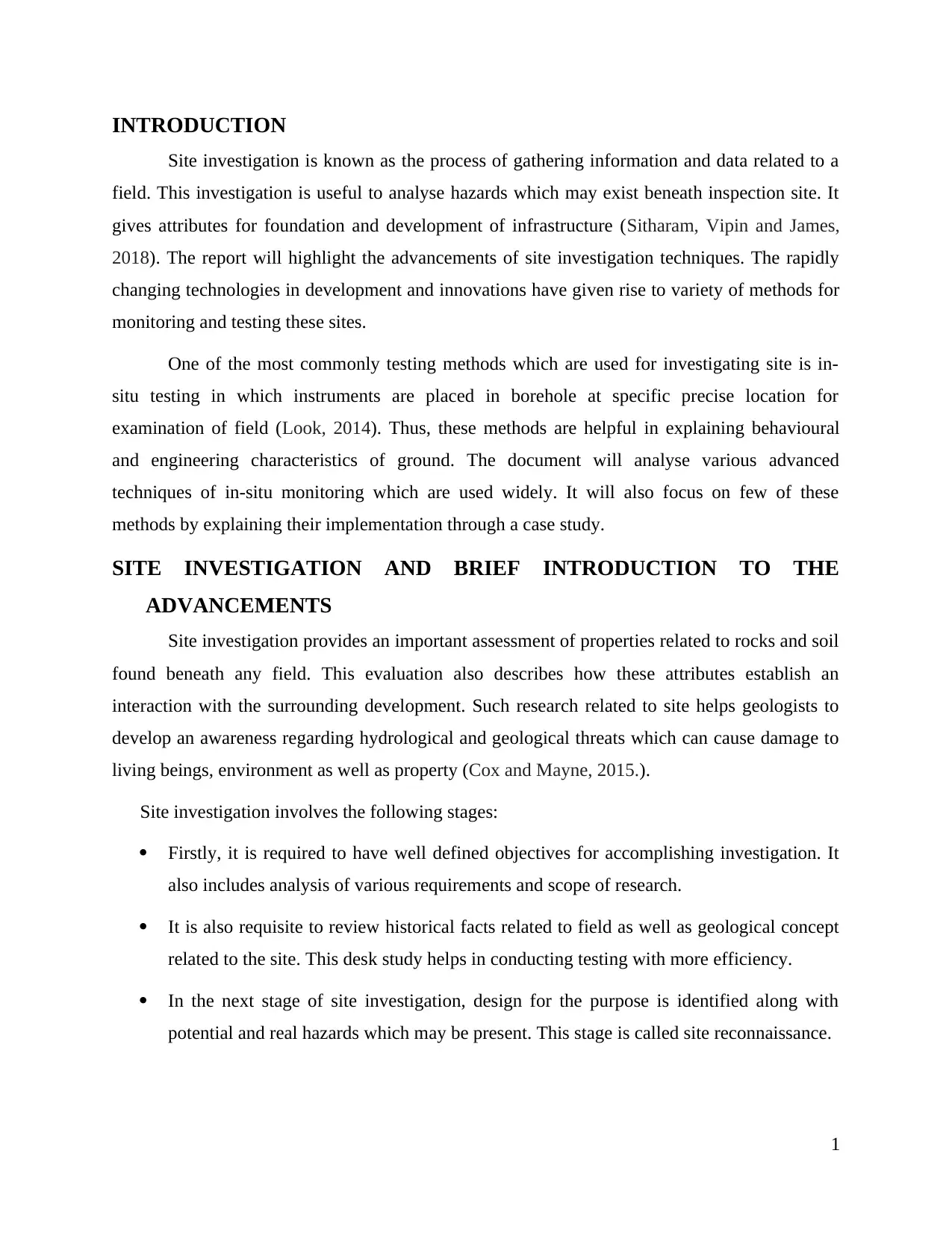
INTRODUCTION
Site investigation is known as the process of gathering information and data related to a
field. This investigation is useful to analyse hazards which may exist beneath inspection site. It
gives attributes for foundation and development of infrastructure (Sitharam, Vipin and James,
2018). The report will highlight the advancements of site investigation techniques. The rapidly
changing technologies in development and innovations have given rise to variety of methods for
monitoring and testing these sites.
One of the most commonly testing methods which are used for investigating site is in-
situ testing in which instruments are placed in borehole at specific precise location for
examination of field (Look, 2014). Thus, these methods are helpful in explaining behavioural
and engineering characteristics of ground. The document will analyse various advanced
techniques of in-situ monitoring which are used widely. It will also focus on few of these
methods by explaining their implementation through a case study.
SITE INVESTIGATION AND BRIEF INTRODUCTION TO THE
ADVANCEMENTS
Site investigation provides an important assessment of properties related to rocks and soil
found beneath any field. This evaluation also describes how these attributes establish an
interaction with the surrounding development. Such research related to site helps geologists to
develop an awareness regarding hydrological and geological threats which can cause damage to
living beings, environment as well as property (Cox and Mayne, 2015.).
Site investigation involves the following stages:
Firstly, it is required to have well defined objectives for accomplishing investigation. It
also includes analysis of various requirements and scope of research.
It is also requisite to review historical facts related to field as well as geological concept
related to the site. This desk study helps in conducting testing with more efficiency.
In the next stage of site investigation, design for the purpose is identified along with
potential and real hazards which may be present. This stage is called site reconnaissance.
1
Site investigation is known as the process of gathering information and data related to a
field. This investigation is useful to analyse hazards which may exist beneath inspection site. It
gives attributes for foundation and development of infrastructure (Sitharam, Vipin and James,
2018). The report will highlight the advancements of site investigation techniques. The rapidly
changing technologies in development and innovations have given rise to variety of methods for
monitoring and testing these sites.
One of the most commonly testing methods which are used for investigating site is in-
situ testing in which instruments are placed in borehole at specific precise location for
examination of field (Look, 2014). Thus, these methods are helpful in explaining behavioural
and engineering characteristics of ground. The document will analyse various advanced
techniques of in-situ monitoring which are used widely. It will also focus on few of these
methods by explaining their implementation through a case study.
SITE INVESTIGATION AND BRIEF INTRODUCTION TO THE
ADVANCEMENTS
Site investigation provides an important assessment of properties related to rocks and soil
found beneath any field. This evaluation also describes how these attributes establish an
interaction with the surrounding development. Such research related to site helps geologists to
develop an awareness regarding hydrological and geological threats which can cause damage to
living beings, environment as well as property (Cox and Mayne, 2015.).
Site investigation involves the following stages:
Firstly, it is required to have well defined objectives for accomplishing investigation. It
also includes analysis of various requirements and scope of research.
It is also requisite to review historical facts related to field as well as geological concept
related to the site. This desk study helps in conducting testing with more efficiency.
In the next stage of site investigation, design for the purpose is identified along with
potential and real hazards which may be present. This stage is called site reconnaissance.
1
⊘ This is a preview!⊘
Do you want full access?
Subscribe today to unlock all pages.

Trusted by 1+ million students worldwide
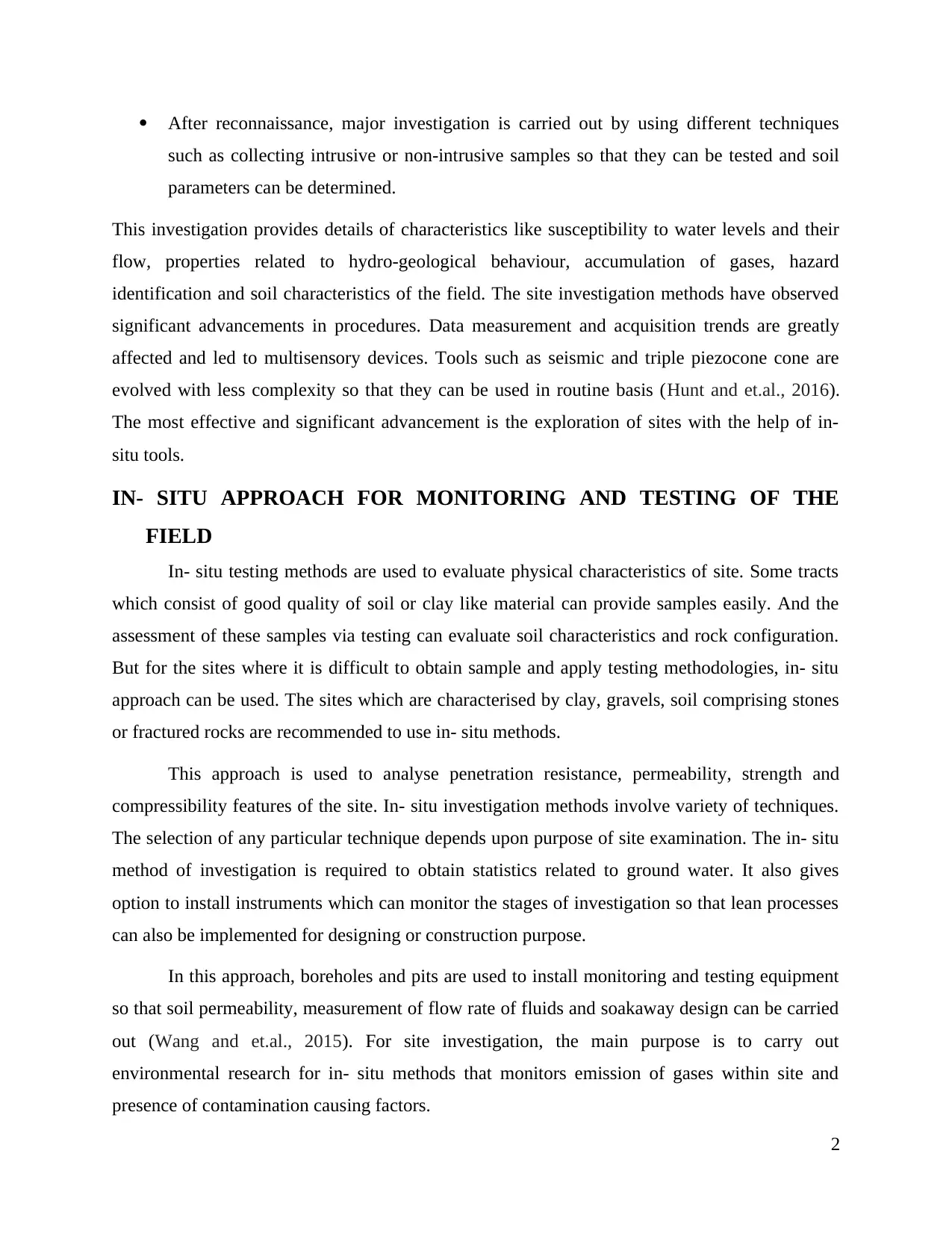
After reconnaissance, major investigation is carried out by using different techniques
such as collecting intrusive or non-intrusive samples so that they can be tested and soil
parameters can be determined.
This investigation provides details of characteristics like susceptibility to water levels and their
flow, properties related to hydro-geological behaviour, accumulation of gases, hazard
identification and soil characteristics of the field. The site investigation methods have observed
significant advancements in procedures. Data measurement and acquisition trends are greatly
affected and led to multisensory devices. Tools such as seismic and triple piezocone cone are
evolved with less complexity so that they can be used in routine basis (Hunt and et.al., 2016).
The most effective and significant advancement is the exploration of sites with the help of in-
situ tools.
IN- SITU APPROACH FOR MONITORING AND TESTING OF THE
FIELD
In- situ testing methods are used to evaluate physical characteristics of site. Some tracts
which consist of good quality of soil or clay like material can provide samples easily. And the
assessment of these samples via testing can evaluate soil characteristics and rock configuration.
But for the sites where it is difficult to obtain sample and apply testing methodologies, in- situ
approach can be used. The sites which are characterised by clay, gravels, soil comprising stones
or fractured rocks are recommended to use in- situ methods.
This approach is used to analyse penetration resistance, permeability, strength and
compressibility features of the site. In- situ investigation methods involve variety of techniques.
The selection of any particular technique depends upon purpose of site examination. The in- situ
method of investigation is required to obtain statistics related to ground water. It also gives
option to install instruments which can monitor the stages of investigation so that lean processes
can also be implemented for designing or construction purpose.
In this approach, boreholes and pits are used to install monitoring and testing equipment
so that soil permeability, measurement of flow rate of fluids and soakaway design can be carried
out (Wang and et.al., 2015). For site investigation, the main purpose is to carry out
environmental research for in- situ methods that monitors emission of gases within site and
presence of contamination causing factors.
2
such as collecting intrusive or non-intrusive samples so that they can be tested and soil
parameters can be determined.
This investigation provides details of characteristics like susceptibility to water levels and their
flow, properties related to hydro-geological behaviour, accumulation of gases, hazard
identification and soil characteristics of the field. The site investigation methods have observed
significant advancements in procedures. Data measurement and acquisition trends are greatly
affected and led to multisensory devices. Tools such as seismic and triple piezocone cone are
evolved with less complexity so that they can be used in routine basis (Hunt and et.al., 2016).
The most effective and significant advancement is the exploration of sites with the help of in-
situ tools.
IN- SITU APPROACH FOR MONITORING AND TESTING OF THE
FIELD
In- situ testing methods are used to evaluate physical characteristics of site. Some tracts
which consist of good quality of soil or clay like material can provide samples easily. And the
assessment of these samples via testing can evaluate soil characteristics and rock configuration.
But for the sites where it is difficult to obtain sample and apply testing methodologies, in- situ
approach can be used. The sites which are characterised by clay, gravels, soil comprising stones
or fractured rocks are recommended to use in- situ methods.
This approach is used to analyse penetration resistance, permeability, strength and
compressibility features of the site. In- situ investigation methods involve variety of techniques.
The selection of any particular technique depends upon purpose of site examination. The in- situ
method of investigation is required to obtain statistics related to ground water. It also gives
option to install instruments which can monitor the stages of investigation so that lean processes
can also be implemented for designing or construction purpose.
In this approach, boreholes and pits are used to install monitoring and testing equipment
so that soil permeability, measurement of flow rate of fluids and soakaway design can be carried
out (Wang and et.al., 2015). For site investigation, the main purpose is to carry out
environmental research for in- situ methods that monitors emission of gases within site and
presence of contamination causing factors.
2
Paraphrase This Document
Need a fresh take? Get an instant paraphrase of this document with our AI Paraphraser
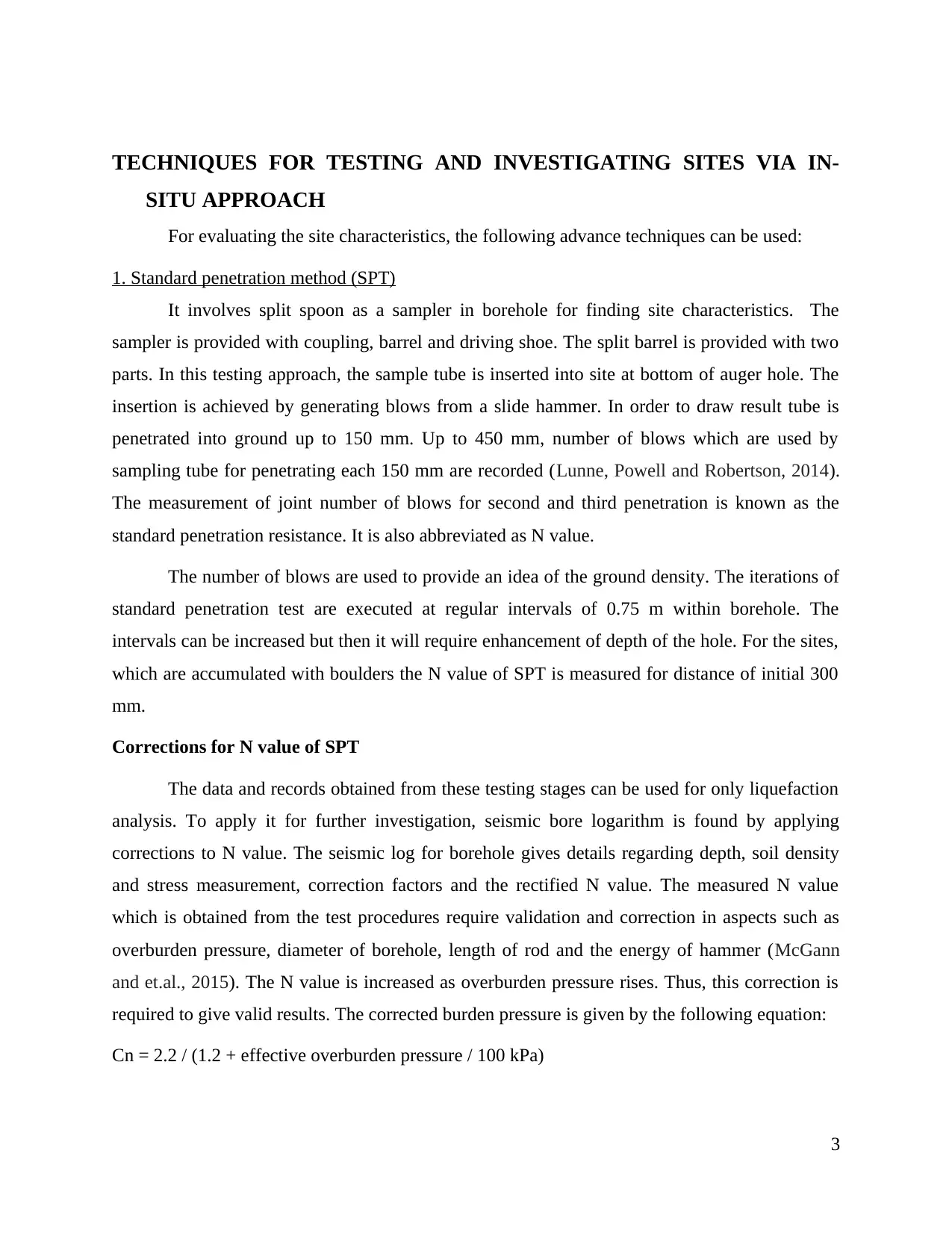
TECHNIQUES FOR TESTING AND INVESTIGATING SITES VIA IN-
SITU APPROACH
For evaluating the site characteristics, the following advance techniques can be used:
1. Standard penetration method (SPT)
It involves split spoon as a sampler in borehole for finding site characteristics. The
sampler is provided with coupling, barrel and driving shoe. The split barrel is provided with two
parts. In this testing approach, the sample tube is inserted into site at bottom of auger hole. The
insertion is achieved by generating blows from a slide hammer. In order to draw result tube is
penetrated into ground up to 150 mm. Up to 450 mm, number of blows which are used by
sampling tube for penetrating each 150 mm are recorded (Lunne, Powell and Robertson, 2014).
The measurement of joint number of blows for second and third penetration is known as the
standard penetration resistance. It is also abbreviated as N value.
The number of blows are used to provide an idea of the ground density. The iterations of
standard penetration test are executed at regular intervals of 0.75 m within borehole. The
intervals can be increased but then it will require enhancement of depth of the hole. For the sites,
which are accumulated with boulders the N value of SPT is measured for distance of initial 300
mm.
Corrections for N value of SPT
The data and records obtained from these testing stages can be used for only liquefaction
analysis. To apply it for further investigation, seismic bore logarithm is found by applying
corrections to N value. The seismic log for borehole gives details regarding depth, soil density
and stress measurement, correction factors and the rectified N value. The measured N value
which is obtained from the test procedures require validation and correction in aspects such as
overburden pressure, diameter of borehole, length of rod and the energy of hammer (McGann
and et.al., 2015). The N value is increased as overburden pressure rises. Thus, this correction is
required to give valid results. The corrected burden pressure is given by the following equation:
Cn = 2.2 / (1.2 + effective overburden pressure / 100 kPa)
3
SITU APPROACH
For evaluating the site characteristics, the following advance techniques can be used:
1. Standard penetration method (SPT)
It involves split spoon as a sampler in borehole for finding site characteristics. The
sampler is provided with coupling, barrel and driving shoe. The split barrel is provided with two
parts. In this testing approach, the sample tube is inserted into site at bottom of auger hole. The
insertion is achieved by generating blows from a slide hammer. In order to draw result tube is
penetrated into ground up to 150 mm. Up to 450 mm, number of blows which are used by
sampling tube for penetrating each 150 mm are recorded (Lunne, Powell and Robertson, 2014).
The measurement of joint number of blows for second and third penetration is known as the
standard penetration resistance. It is also abbreviated as N value.
The number of blows are used to provide an idea of the ground density. The iterations of
standard penetration test are executed at regular intervals of 0.75 m within borehole. The
intervals can be increased but then it will require enhancement of depth of the hole. For the sites,
which are accumulated with boulders the N value of SPT is measured for distance of initial 300
mm.
Corrections for N value of SPT
The data and records obtained from these testing stages can be used for only liquefaction
analysis. To apply it for further investigation, seismic bore logarithm is found by applying
corrections to N value. The seismic log for borehole gives details regarding depth, soil density
and stress measurement, correction factors and the rectified N value. The measured N value
which is obtained from the test procedures require validation and correction in aspects such as
overburden pressure, diameter of borehole, length of rod and the energy of hammer (McGann
and et.al., 2015). The N value is increased as overburden pressure rises. Thus, this correction is
required to give valid results. The corrected burden pressure is given by the following equation:
Cn = 2.2 / (1.2 + effective overburden pressure / 100 kPa)
3
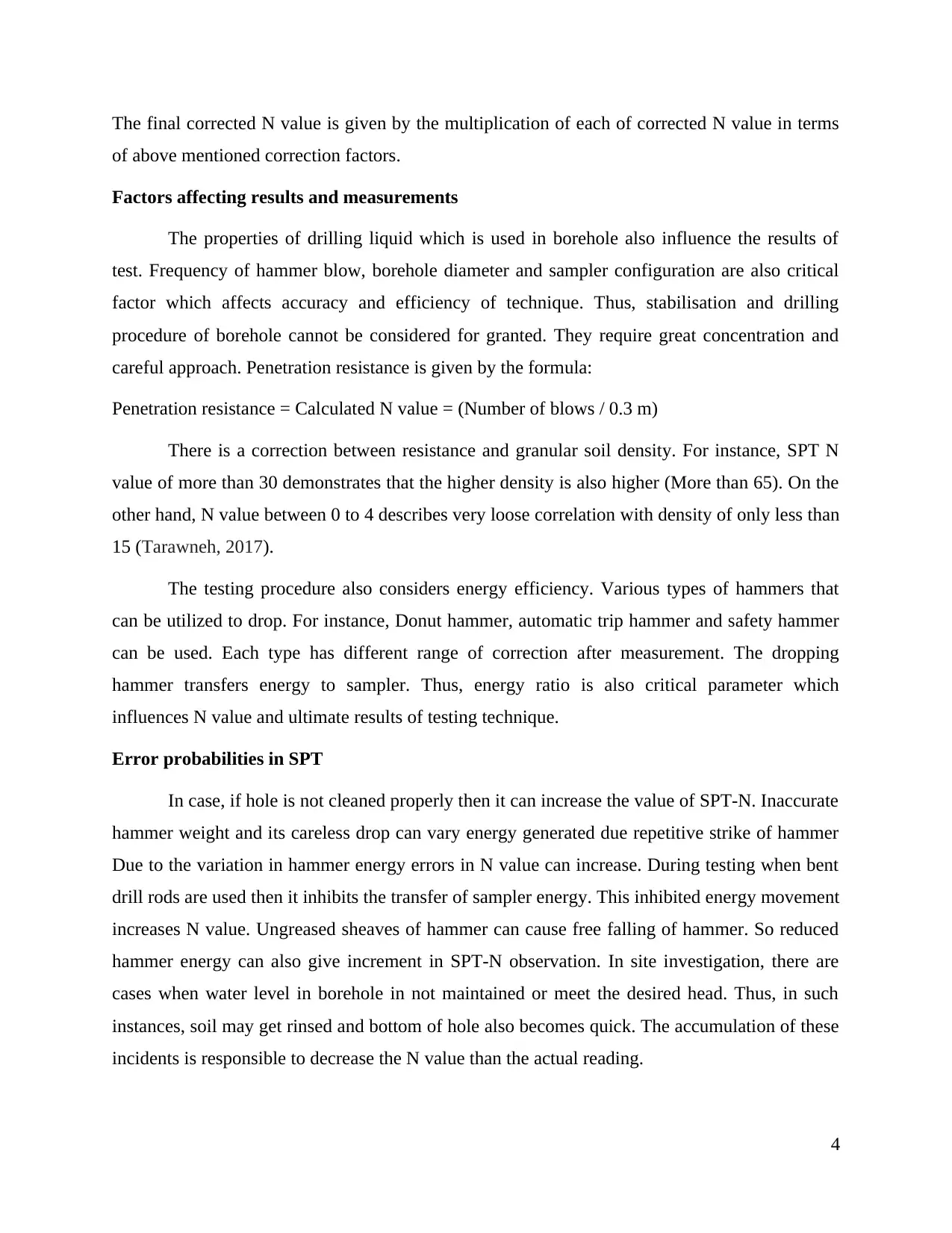
The final corrected N value is given by the multiplication of each of corrected N value in terms
of above mentioned correction factors.
Factors affecting results and measurements
The properties of drilling liquid which is used in borehole also influence the results of
test. Frequency of hammer blow, borehole diameter and sampler configuration are also critical
factor which affects accuracy and efficiency of technique. Thus, stabilisation and drilling
procedure of borehole cannot be considered for granted. They require great concentration and
careful approach. Penetration resistance is given by the formula:
Penetration resistance = Calculated N value = (Number of blows / 0.3 m)
There is a correction between resistance and granular soil density. For instance, SPT N
value of more than 30 demonstrates that the higher density is also higher (More than 65). On the
other hand, N value between 0 to 4 describes very loose correlation with density of only less than
15 (Tarawneh, 2017).
The testing procedure also considers energy efficiency. Various types of hammers that
can be utilized to drop. For instance, Donut hammer, automatic trip hammer and safety hammer
can be used. Each type has different range of correction after measurement. The dropping
hammer transfers energy to sampler. Thus, energy ratio is also critical parameter which
influences N value and ultimate results of testing technique.
Error probabilities in SPT
In case, if hole is not cleaned properly then it can increase the value of SPT-N. Inaccurate
hammer weight and its careless drop can vary energy generated due repetitive strike of hammer
Due to the variation in hammer energy errors in N value can increase. During testing when bent
drill rods are used then it inhibits the transfer of sampler energy. This inhibited energy movement
increases N value. Ungreased sheaves of hammer can cause free falling of hammer. So reduced
hammer energy can also give increment in SPT-N observation. In site investigation, there are
cases when water level in borehole in not maintained or meet the desired head. Thus, in such
instances, soil may get rinsed and bottom of hole also becomes quick. The accumulation of these
incidents is responsible to decrease the N value than the actual reading.
4
of above mentioned correction factors.
Factors affecting results and measurements
The properties of drilling liquid which is used in borehole also influence the results of
test. Frequency of hammer blow, borehole diameter and sampler configuration are also critical
factor which affects accuracy and efficiency of technique. Thus, stabilisation and drilling
procedure of borehole cannot be considered for granted. They require great concentration and
careful approach. Penetration resistance is given by the formula:
Penetration resistance = Calculated N value = (Number of blows / 0.3 m)
There is a correction between resistance and granular soil density. For instance, SPT N
value of more than 30 demonstrates that the higher density is also higher (More than 65). On the
other hand, N value between 0 to 4 describes very loose correlation with density of only less than
15 (Tarawneh, 2017).
The testing procedure also considers energy efficiency. Various types of hammers that
can be utilized to drop. For instance, Donut hammer, automatic trip hammer and safety hammer
can be used. Each type has different range of correction after measurement. The dropping
hammer transfers energy to sampler. Thus, energy ratio is also critical parameter which
influences N value and ultimate results of testing technique.
Error probabilities in SPT
In case, if hole is not cleaned properly then it can increase the value of SPT-N. Inaccurate
hammer weight and its careless drop can vary energy generated due repetitive strike of hammer
Due to the variation in hammer energy errors in N value can increase. During testing when bent
drill rods are used then it inhibits the transfer of sampler energy. This inhibited energy movement
increases N value. Ungreased sheaves of hammer can cause free falling of hammer. So reduced
hammer energy can also give increment in SPT-N observation. In site investigation, there are
cases when water level in borehole in not maintained or meet the desired head. Thus, in such
instances, soil may get rinsed and bottom of hole also becomes quick. The accumulation of these
incidents is responsible to decrease the N value than the actual reading.
4
⊘ This is a preview!⊘
Do you want full access?
Subscribe today to unlock all pages.

Trusted by 1+ million students worldwide
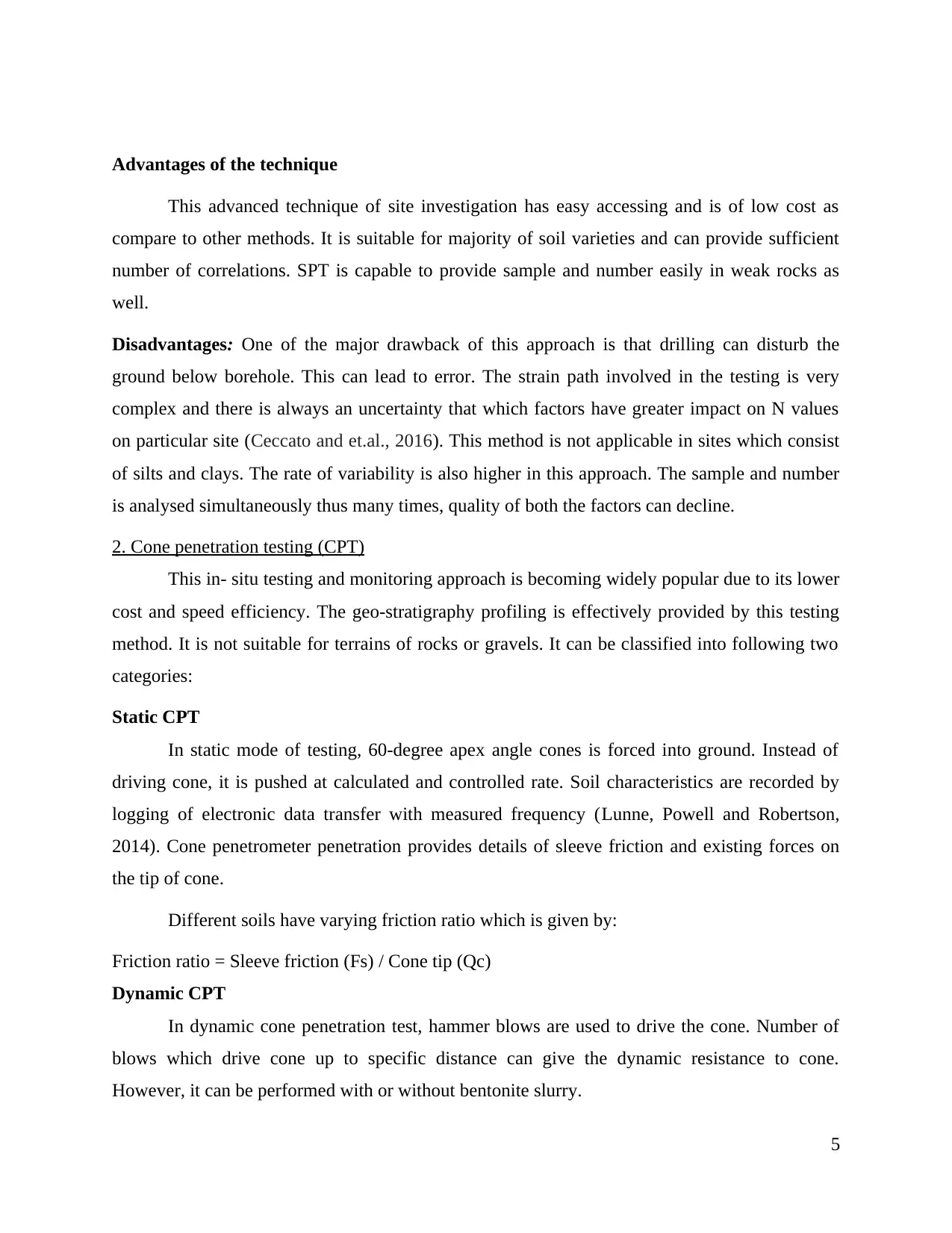
Advantages of the technique
This advanced technique of site investigation has easy accessing and is of low cost as
compare to other methods. It is suitable for majority of soil varieties and can provide sufficient
number of correlations. SPT is capable to provide sample and number easily in weak rocks as
well.
Disadvantages: One of the major drawback of this approach is that drilling can disturb the
ground below borehole. This can lead to error. The strain path involved in the testing is very
complex and there is always an uncertainty that which factors have greater impact on N values
on particular site (Ceccato and et.al., 2016). This method is not applicable in sites which consist
of silts and clays. The rate of variability is also higher in this approach. The sample and number
is analysed simultaneously thus many times, quality of both the factors can decline.
2. Cone penetration testing (CPT)
This in- situ testing and monitoring approach is becoming widely popular due to its lower
cost and speed efficiency. The geo-stratigraphy profiling is effectively provided by this testing
method. It is not suitable for terrains of rocks or gravels. It can be classified into following two
categories:
Static CPT
In static mode of testing, 60-degree apex angle cones is forced into ground. Instead of
driving cone, it is pushed at calculated and controlled rate. Soil characteristics are recorded by
logging of electronic data transfer with measured frequency (Lunne, Powell and Robertson,
2014). Cone penetrometer penetration provides details of sleeve friction and existing forces on
the tip of cone.
Different soils have varying friction ratio which is given by:
Friction ratio = Sleeve friction (Fs) / Cone tip (Qc)
Dynamic CPT
In dynamic cone penetration test, hammer blows are used to drive the cone. Number of
blows which drive cone up to specific distance can give the dynamic resistance to cone.
However, it can be performed with or without bentonite slurry.
5
This advanced technique of site investigation has easy accessing and is of low cost as
compare to other methods. It is suitable for majority of soil varieties and can provide sufficient
number of correlations. SPT is capable to provide sample and number easily in weak rocks as
well.
Disadvantages: One of the major drawback of this approach is that drilling can disturb the
ground below borehole. This can lead to error. The strain path involved in the testing is very
complex and there is always an uncertainty that which factors have greater impact on N values
on particular site (Ceccato and et.al., 2016). This method is not applicable in sites which consist
of silts and clays. The rate of variability is also higher in this approach. The sample and number
is analysed simultaneously thus many times, quality of both the factors can decline.
2. Cone penetration testing (CPT)
This in- situ testing and monitoring approach is becoming widely popular due to its lower
cost and speed efficiency. The geo-stratigraphy profiling is effectively provided by this testing
method. It is not suitable for terrains of rocks or gravels. It can be classified into following two
categories:
Static CPT
In static mode of testing, 60-degree apex angle cones is forced into ground. Instead of
driving cone, it is pushed at calculated and controlled rate. Soil characteristics are recorded by
logging of electronic data transfer with measured frequency (Lunne, Powell and Robertson,
2014). Cone penetrometer penetration provides details of sleeve friction and existing forces on
the tip of cone.
Different soils have varying friction ratio which is given by:
Friction ratio = Sleeve friction (Fs) / Cone tip (Qc)
Dynamic CPT
In dynamic cone penetration test, hammer blows are used to drive the cone. Number of
blows which drive cone up to specific distance can give the dynamic resistance to cone.
However, it can be performed with or without bentonite slurry.
5
Paraphrase This Document
Need a fresh take? Get an instant paraphrase of this document with our AI Paraphraser
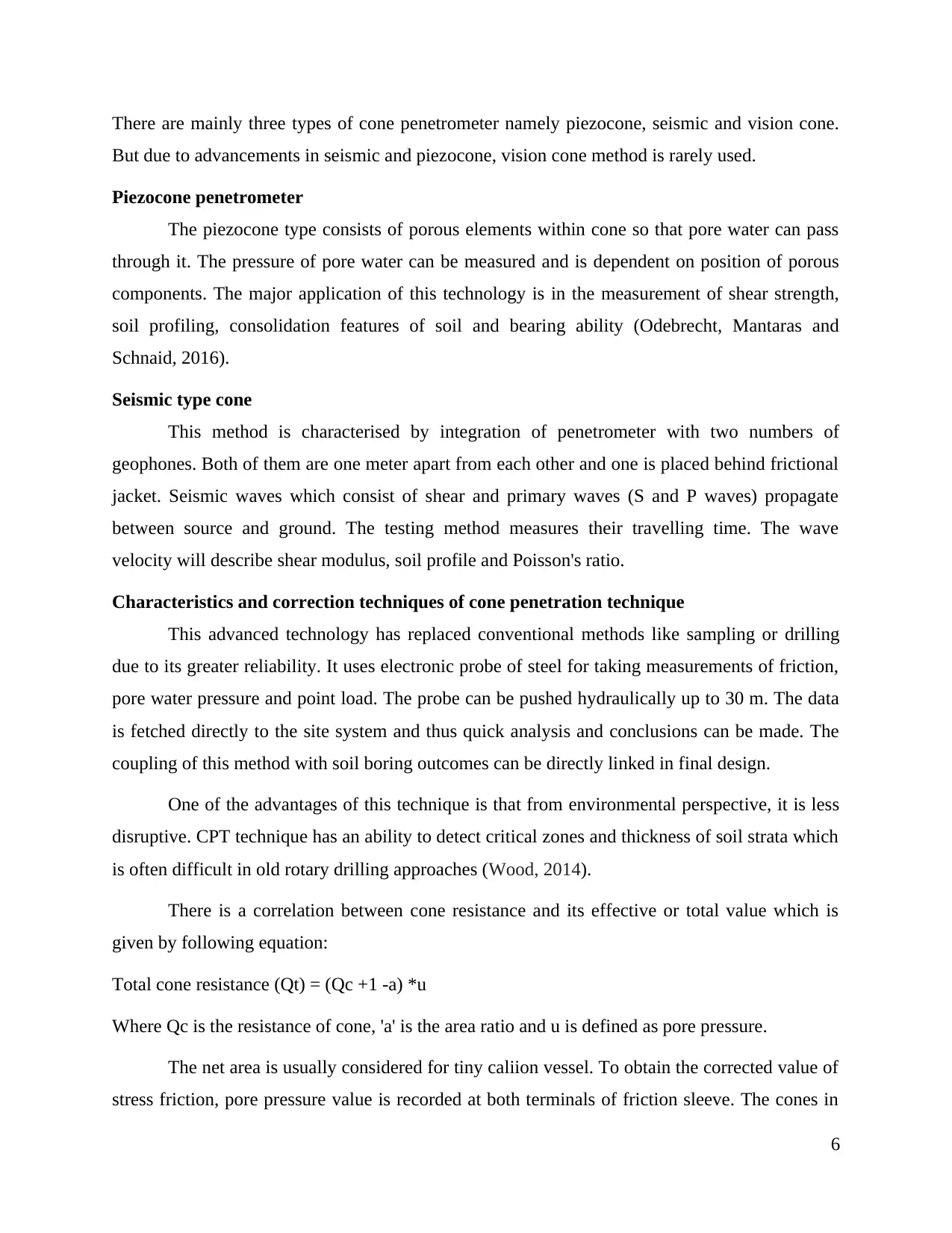
There are mainly three types of cone penetrometer namely piezocone, seismic and vision cone.
But due to advancements in seismic and piezocone, vision cone method is rarely used.
Piezocone penetrometer
The piezocone type consists of porous elements within cone so that pore water can pass
through it. The pressure of pore water can be measured and is dependent on position of porous
components. The major application of this technology is in the measurement of shear strength,
soil profiling, consolidation features of soil and bearing ability (Odebrecht, Mantaras and
Schnaid, 2016).
Seismic type cone
This method is characterised by integration of penetrometer with two numbers of
geophones. Both of them are one meter apart from each other and one is placed behind frictional
jacket. Seismic waves which consist of shear and primary waves (S and P waves) propagate
between source and ground. The testing method measures their travelling time. The wave
velocity will describe shear modulus, soil profile and Poisson's ratio.
Characteristics and correction techniques of cone penetration technique
This advanced technology has replaced conventional methods like sampling or drilling
due to its greater reliability. It uses electronic probe of steel for taking measurements of friction,
pore water pressure and point load. The probe can be pushed hydraulically up to 30 m. The data
is fetched directly to the site system and thus quick analysis and conclusions can be made. The
coupling of this method with soil boring outcomes can be directly linked in final design.
One of the advantages of this technique is that from environmental perspective, it is less
disruptive. CPT technique has an ability to detect critical zones and thickness of soil strata which
is often difficult in old rotary drilling approaches (Wood, 2014).
There is a correlation between cone resistance and its effective or total value which is
given by following equation:
Total cone resistance (Qt) = (Qc +1 -a) *u
Where Qc is the resistance of cone, 'a' is the area ratio and u is defined as pore pressure.
The net area is usually considered for tiny caliion vessel. To obtain the corrected value of
stress friction, pore pressure value is recorded at both terminals of friction sleeve. The cones in
6
But due to advancements in seismic and piezocone, vision cone method is rarely used.
Piezocone penetrometer
The piezocone type consists of porous elements within cone so that pore water can pass
through it. The pressure of pore water can be measured and is dependent on position of porous
components. The major application of this technology is in the measurement of shear strength,
soil profiling, consolidation features of soil and bearing ability (Odebrecht, Mantaras and
Schnaid, 2016).
Seismic type cone
This method is characterised by integration of penetrometer with two numbers of
geophones. Both of them are one meter apart from each other and one is placed behind frictional
jacket. Seismic waves which consist of shear and primary waves (S and P waves) propagate
between source and ground. The testing method measures their travelling time. The wave
velocity will describe shear modulus, soil profile and Poisson's ratio.
Characteristics and correction techniques of cone penetration technique
This advanced technology has replaced conventional methods like sampling or drilling
due to its greater reliability. It uses electronic probe of steel for taking measurements of friction,
pore water pressure and point load. The probe can be pushed hydraulically up to 30 m. The data
is fetched directly to the site system and thus quick analysis and conclusions can be made. The
coupling of this method with soil boring outcomes can be directly linked in final design.
One of the advantages of this technique is that from environmental perspective, it is less
disruptive. CPT technique has an ability to detect critical zones and thickness of soil strata which
is often difficult in old rotary drilling approaches (Wood, 2014).
There is a correlation between cone resistance and its effective or total value which is
given by following equation:
Total cone resistance (Qt) = (Qc +1 -a) *u
Where Qc is the resistance of cone, 'a' is the area ratio and u is defined as pore pressure.
The net area is usually considered for tiny caliion vessel. To obtain the corrected value of
stress friction, pore pressure value is recorded at both terminals of friction sleeve. The cones in
6
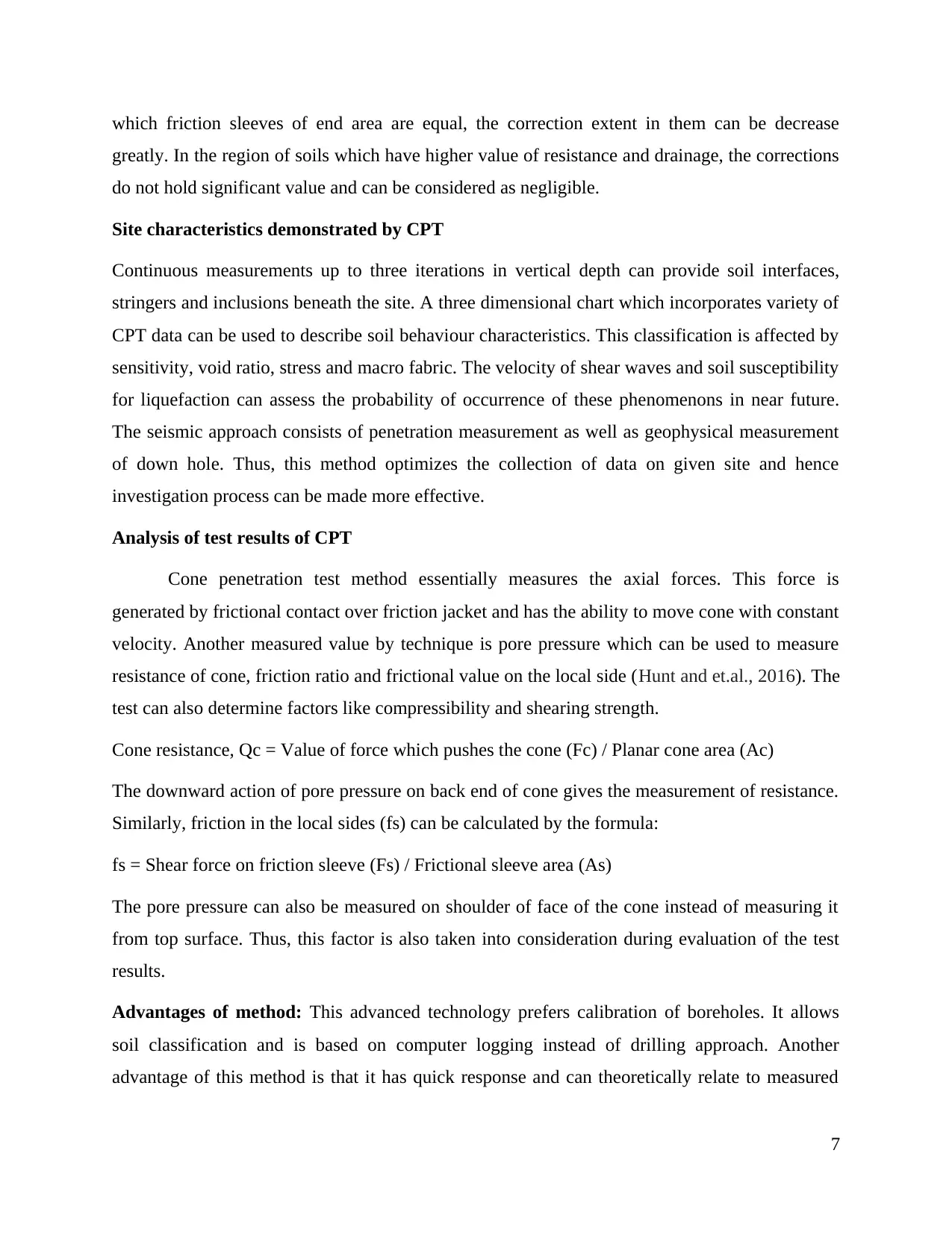
which friction sleeves of end area are equal, the correction extent in them can be decrease
greatly. In the region of soils which have higher value of resistance and drainage, the corrections
do not hold significant value and can be considered as negligible.
Site characteristics demonstrated by CPT
Continuous measurements up to three iterations in vertical depth can provide soil interfaces,
stringers and inclusions beneath the site. A three dimensional chart which incorporates variety of
CPT data can be used to describe soil behaviour characteristics. This classification is affected by
sensitivity, void ratio, stress and macro fabric. The velocity of shear waves and soil susceptibility
for liquefaction can assess the probability of occurrence of these phenomenons in near future.
The seismic approach consists of penetration measurement as well as geophysical measurement
of down hole. Thus, this method optimizes the collection of data on given site and hence
investigation process can be made more effective.
Analysis of test results of CPT
Cone penetration test method essentially measures the axial forces. This force is
generated by frictional contact over friction jacket and has the ability to move cone with constant
velocity. Another measured value by technique is pore pressure which can be used to measure
resistance of cone, friction ratio and frictional value on the local side (Hunt and et.al., 2016). The
test can also determine factors like compressibility and shearing strength.
Cone resistance, Qc = Value of force which pushes the cone (Fc) / Planar cone area (Ac)
The downward action of pore pressure on back end of cone gives the measurement of resistance.
Similarly, friction in the local sides (fs) can be calculated by the formula:
fs = Shear force on friction sleeve (Fs) / Frictional sleeve area (As)
The pore pressure can also be measured on shoulder of face of the cone instead of measuring it
from top surface. Thus, this factor is also taken into consideration during evaluation of the test
results.
Advantages of method: This advanced technology prefers calibration of boreholes. It allows
soil classification and is based on computer logging instead of drilling approach. Another
advantage of this method is that it has quick response and can theoretically relate to measured
7
greatly. In the region of soils which have higher value of resistance and drainage, the corrections
do not hold significant value and can be considered as negligible.
Site characteristics demonstrated by CPT
Continuous measurements up to three iterations in vertical depth can provide soil interfaces,
stringers and inclusions beneath the site. A three dimensional chart which incorporates variety of
CPT data can be used to describe soil behaviour characteristics. This classification is affected by
sensitivity, void ratio, stress and macro fabric. The velocity of shear waves and soil susceptibility
for liquefaction can assess the probability of occurrence of these phenomenons in near future.
The seismic approach consists of penetration measurement as well as geophysical measurement
of down hole. Thus, this method optimizes the collection of data on given site and hence
investigation process can be made more effective.
Analysis of test results of CPT
Cone penetration test method essentially measures the axial forces. This force is
generated by frictional contact over friction jacket and has the ability to move cone with constant
velocity. Another measured value by technique is pore pressure which can be used to measure
resistance of cone, friction ratio and frictional value on the local side (Hunt and et.al., 2016). The
test can also determine factors like compressibility and shearing strength.
Cone resistance, Qc = Value of force which pushes the cone (Fc) / Planar cone area (Ac)
The downward action of pore pressure on back end of cone gives the measurement of resistance.
Similarly, friction in the local sides (fs) can be calculated by the formula:
fs = Shear force on friction sleeve (Fs) / Frictional sleeve area (As)
The pore pressure can also be measured on shoulder of face of the cone instead of measuring it
from top surface. Thus, this factor is also taken into consideration during evaluation of the test
results.
Advantages of method: This advanced technology prefers calibration of boreholes. It allows
soil classification and is based on computer logging instead of drilling approach. Another
advantage of this method is that it has quick response and can theoretically relate to measured
7
⊘ This is a preview!⊘
Do you want full access?
Subscribe today to unlock all pages.

Trusted by 1+ million students worldwide
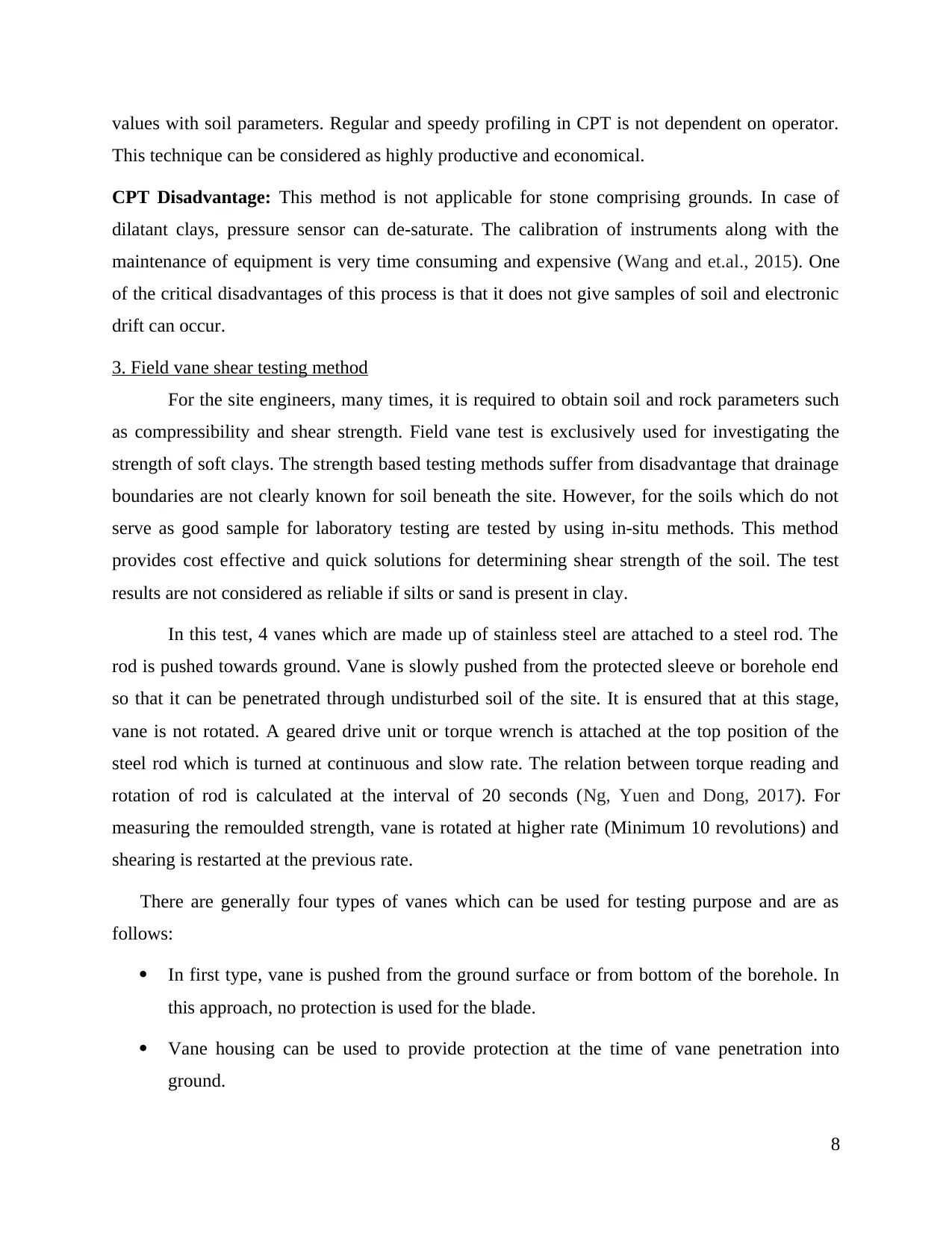
values with soil parameters. Regular and speedy profiling in CPT is not dependent on operator.
This technique can be considered as highly productive and economical.
CPT Disadvantage: This method is not applicable for stone comprising grounds. In case of
dilatant clays, pressure sensor can de-saturate. The calibration of instruments along with the
maintenance of equipment is very time consuming and expensive (Wang and et.al., 2015). One
of the critical disadvantages of this process is that it does not give samples of soil and electronic
drift can occur.
3. Field vane shear testing method
For the site engineers, many times, it is required to obtain soil and rock parameters such
as compressibility and shear strength. Field vane test is exclusively used for investigating the
strength of soft clays. The strength based testing methods suffer from disadvantage that drainage
boundaries are not clearly known for soil beneath the site. However, for the soils which do not
serve as good sample for laboratory testing are tested by using in-situ methods. This method
provides cost effective and quick solutions for determining shear strength of the soil. The test
results are not considered as reliable if silts or sand is present in clay.
In this test, 4 vanes which are made up of stainless steel are attached to a steel rod. The
rod is pushed towards ground. Vane is slowly pushed from the protected sleeve or borehole end
so that it can be penetrated through undisturbed soil of the site. It is ensured that at this stage,
vane is not rotated. A geared drive unit or torque wrench is attached at the top position of the
steel rod which is turned at continuous and slow rate. The relation between torque reading and
rotation of rod is calculated at the interval of 20 seconds (Ng, Yuen and Dong, 2017). For
measuring the remoulded strength, vane is rotated at higher rate (Minimum 10 revolutions) and
shearing is restarted at the previous rate.
There are generally four types of vanes which can be used for testing purpose and are as
follows:
In first type, vane is pushed from the ground surface or from bottom of the borehole. In
this approach, no protection is used for the blade.
Vane housing can be used to provide protection at the time of vane penetration into
ground.
8
This technique can be considered as highly productive and economical.
CPT Disadvantage: This method is not applicable for stone comprising grounds. In case of
dilatant clays, pressure sensor can de-saturate. The calibration of instruments along with the
maintenance of equipment is very time consuming and expensive (Wang and et.al., 2015). One
of the critical disadvantages of this process is that it does not give samples of soil and electronic
drift can occur.
3. Field vane shear testing method
For the site engineers, many times, it is required to obtain soil and rock parameters such
as compressibility and shear strength. Field vane test is exclusively used for investigating the
strength of soft clays. The strength based testing methods suffer from disadvantage that drainage
boundaries are not clearly known for soil beneath the site. However, for the soils which do not
serve as good sample for laboratory testing are tested by using in-situ methods. This method
provides cost effective and quick solutions for determining shear strength of the soil. The test
results are not considered as reliable if silts or sand is present in clay.
In this test, 4 vanes which are made up of stainless steel are attached to a steel rod. The
rod is pushed towards ground. Vane is slowly pushed from the protected sleeve or borehole end
so that it can be penetrated through undisturbed soil of the site. It is ensured that at this stage,
vane is not rotated. A geared drive unit or torque wrench is attached at the top position of the
steel rod which is turned at continuous and slow rate. The relation between torque reading and
rotation of rod is calculated at the interval of 20 seconds (Ng, Yuen and Dong, 2017). For
measuring the remoulded strength, vane is rotated at higher rate (Minimum 10 revolutions) and
shearing is restarted at the previous rate.
There are generally four types of vanes which can be used for testing purpose and are as
follows:
In first type, vane is pushed from the ground surface or from bottom of the borehole. In
this approach, no protection is used for the blade.
Vane housing can be used to provide protection at the time of vane penetration into
ground.
8
Paraphrase This Document
Need a fresh take? Get an instant paraphrase of this document with our AI Paraphraser
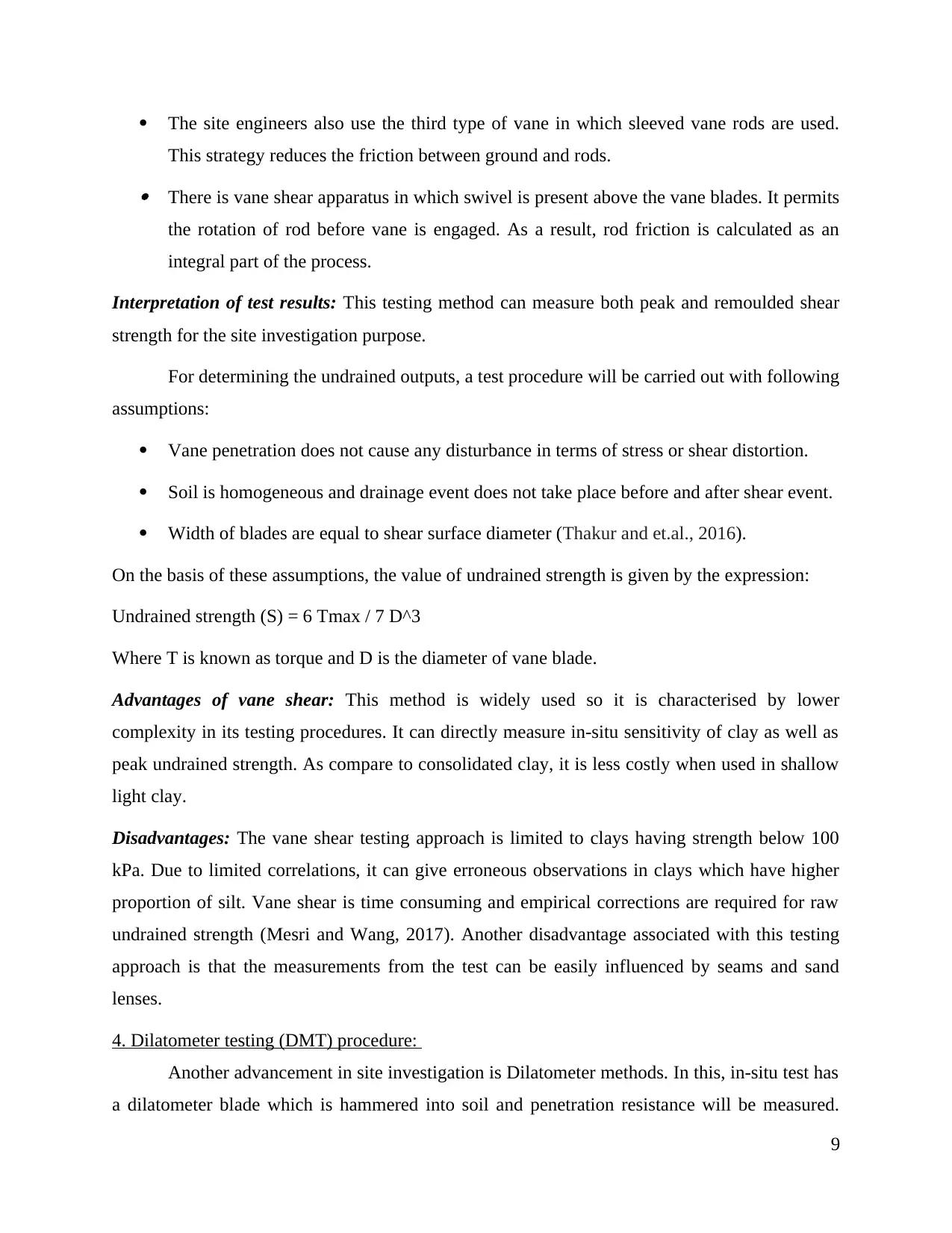
The site engineers also use the third type of vane in which sleeved vane rods are used.
This strategy reduces the friction between ground and rods. There is vane shear apparatus in which swivel is present above the vane blades. It permits
the rotation of rod before vane is engaged. As a result, rod friction is calculated as an
integral part of the process.
Interpretation of test results: This testing method can measure both peak and remoulded shear
strength for the site investigation purpose.
For determining the undrained outputs, a test procedure will be carried out with following
assumptions:
Vane penetration does not cause any disturbance in terms of stress or shear distortion.
Soil is homogeneous and drainage event does not take place before and after shear event.
Width of blades are equal to shear surface diameter (Thakur and et.al., 2016).
On the basis of these assumptions, the value of undrained strength is given by the expression:
Undrained strength (S) = 6 Tmax / 7 D^3
Where T is known as torque and D is the diameter of vane blade.
Advantages of vane shear: This method is widely used so it is characterised by lower
complexity in its testing procedures. It can directly measure in-situ sensitivity of clay as well as
peak undrained strength. As compare to consolidated clay, it is less costly when used in shallow
light clay.
Disadvantages: The vane shear testing approach is limited to clays having strength below 100
kPa. Due to limited correlations, it can give erroneous observations in clays which have higher
proportion of silt. Vane shear is time consuming and empirical corrections are required for raw
undrained strength (Mesri and Wang, 2017). Another disadvantage associated with this testing
approach is that the measurements from the test can be easily influenced by seams and sand
lenses.
4. Dilatometer testing (DMT) procedure:
Another advancement in site investigation is Dilatometer methods. In this, in-situ test has
a dilatometer blade which is hammered into soil and penetration resistance will be measured.
9
This strategy reduces the friction between ground and rods. There is vane shear apparatus in which swivel is present above the vane blades. It permits
the rotation of rod before vane is engaged. As a result, rod friction is calculated as an
integral part of the process.
Interpretation of test results: This testing method can measure both peak and remoulded shear
strength for the site investigation purpose.
For determining the undrained outputs, a test procedure will be carried out with following
assumptions:
Vane penetration does not cause any disturbance in terms of stress or shear distortion.
Soil is homogeneous and drainage event does not take place before and after shear event.
Width of blades are equal to shear surface diameter (Thakur and et.al., 2016).
On the basis of these assumptions, the value of undrained strength is given by the expression:
Undrained strength (S) = 6 Tmax / 7 D^3
Where T is known as torque and D is the diameter of vane blade.
Advantages of vane shear: This method is widely used so it is characterised by lower
complexity in its testing procedures. It can directly measure in-situ sensitivity of clay as well as
peak undrained strength. As compare to consolidated clay, it is less costly when used in shallow
light clay.
Disadvantages: The vane shear testing approach is limited to clays having strength below 100
kPa. Due to limited correlations, it can give erroneous observations in clays which have higher
proportion of silt. Vane shear is time consuming and empirical corrections are required for raw
undrained strength (Mesri and Wang, 2017). Another disadvantage associated with this testing
approach is that the measurements from the test can be easily influenced by seams and sand
lenses.
4. Dilatometer testing (DMT) procedure:
Another advancement in site investigation is Dilatometer methods. In this, in-situ test has
a dilatometer blade which is hammered into soil and penetration resistance will be measured.
9
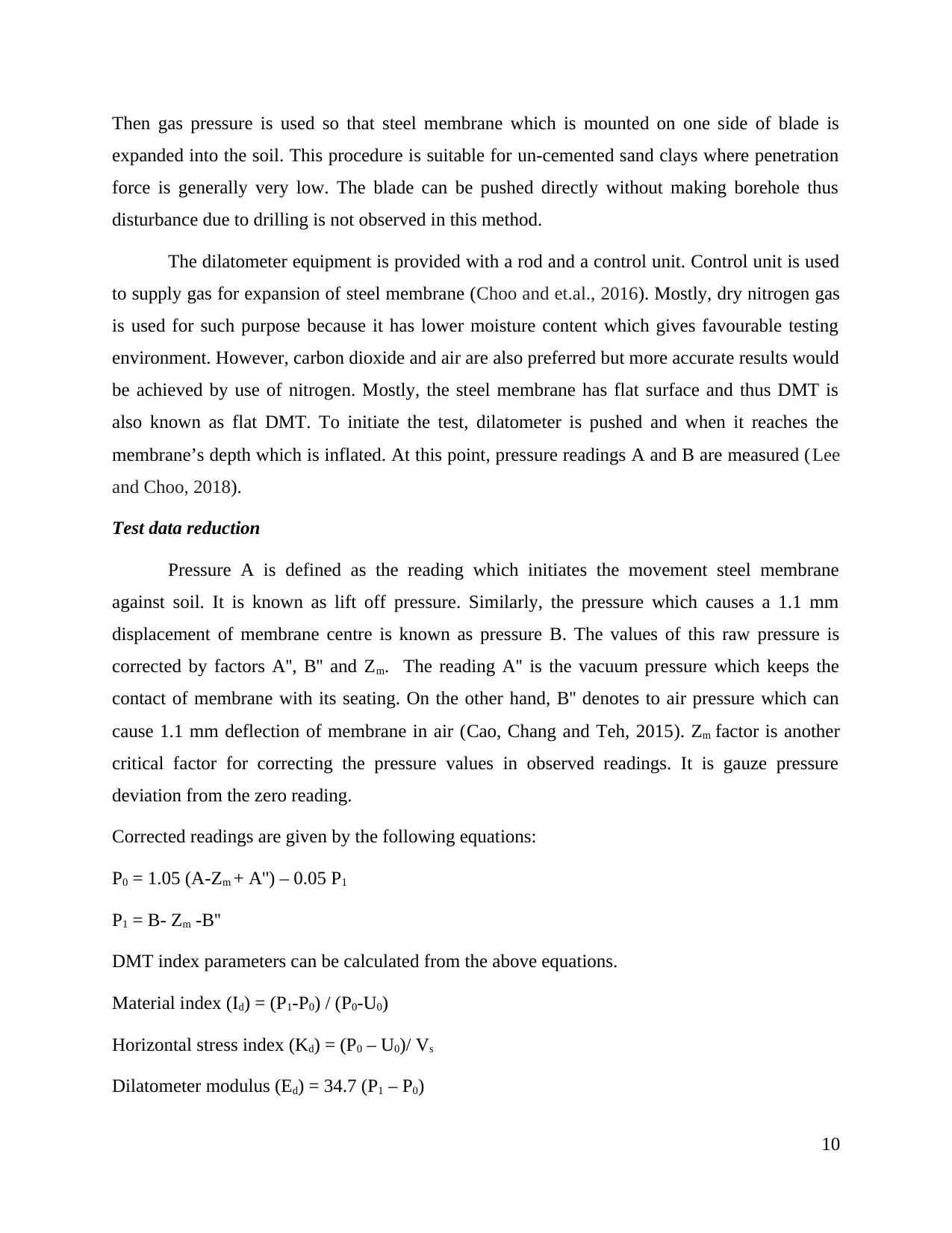
Then gas pressure is used so that steel membrane which is mounted on one side of blade is
expanded into the soil. This procedure is suitable for un-cemented sand clays where penetration
force is generally very low. The blade can be pushed directly without making borehole thus
disturbance due to drilling is not observed in this method.
The dilatometer equipment is provided with a rod and a control unit. Control unit is used
to supply gas for expansion of steel membrane (Choo and et.al., 2016). Mostly, dry nitrogen gas
is used for such purpose because it has lower moisture content which gives favourable testing
environment. However, carbon dioxide and air are also preferred but more accurate results would
be achieved by use of nitrogen. Mostly, the steel membrane has flat surface and thus DMT is
also known as flat DMT. To initiate the test, dilatometer is pushed and when it reaches the
membrane’s depth which is inflated. At this point, pressure readings A and B are measured (Lee
and Choo, 2018).
Test data reduction
Pressure A is defined as the reading which initiates the movement steel membrane
against soil. It is known as lift off pressure. Similarly, the pressure which causes a 1.1 mm
displacement of membrane centre is known as pressure B. The values of this raw pressure is
corrected by factors A'', B'' and Zm. The reading A'' is the vacuum pressure which keeps the
contact of membrane with its seating. On the other hand, B'' denotes to air pressure which can
cause 1.1 mm deflection of membrane in air (Cao, Chang and Teh, 2015). Zm factor is another
critical factor for correcting the pressure values in observed readings. It is gauze pressure
deviation from the zero reading.
Corrected readings are given by the following equations:
P0 = 1.05 (A-Zm + A'') – 0.05 P1
P1 = B- Zm -B''
DMT index parameters can be calculated from the above equations.
Material index (Id) = (P1-P0) / (P0-U0)
Horizontal stress index (Kd) = (P0 – U0)/ Vs
Dilatometer modulus (Ed) = 34.7 (P1 – P0)
10
expanded into the soil. This procedure is suitable for un-cemented sand clays where penetration
force is generally very low. The blade can be pushed directly without making borehole thus
disturbance due to drilling is not observed in this method.
The dilatometer equipment is provided with a rod and a control unit. Control unit is used
to supply gas for expansion of steel membrane (Choo and et.al., 2016). Mostly, dry nitrogen gas
is used for such purpose because it has lower moisture content which gives favourable testing
environment. However, carbon dioxide and air are also preferred but more accurate results would
be achieved by use of nitrogen. Mostly, the steel membrane has flat surface and thus DMT is
also known as flat DMT. To initiate the test, dilatometer is pushed and when it reaches the
membrane’s depth which is inflated. At this point, pressure readings A and B are measured (Lee
and Choo, 2018).
Test data reduction
Pressure A is defined as the reading which initiates the movement steel membrane
against soil. It is known as lift off pressure. Similarly, the pressure which causes a 1.1 mm
displacement of membrane centre is known as pressure B. The values of this raw pressure is
corrected by factors A'', B'' and Zm. The reading A'' is the vacuum pressure which keeps the
contact of membrane with its seating. On the other hand, B'' denotes to air pressure which can
cause 1.1 mm deflection of membrane in air (Cao, Chang and Teh, 2015). Zm factor is another
critical factor for correcting the pressure values in observed readings. It is gauze pressure
deviation from the zero reading.
Corrected readings are given by the following equations:
P0 = 1.05 (A-Zm + A'') – 0.05 P1
P1 = B- Zm -B''
DMT index parameters can be calculated from the above equations.
Material index (Id) = (P1-P0) / (P0-U0)
Horizontal stress index (Kd) = (P0 – U0)/ Vs
Dilatometer modulus (Ed) = 34.7 (P1 – P0)
10
⊘ This is a preview!⊘
Do you want full access?
Subscribe today to unlock all pages.

Trusted by 1+ million students worldwide
1 out of 26
Related Documents
Your All-in-One AI-Powered Toolkit for Academic Success.
+13062052269
info@desklib.com
Available 24*7 on WhatsApp / Email
![[object Object]](/_next/static/media/star-bottom.7253800d.svg)
Unlock your academic potential
Copyright © 2020–2025 A2Z Services. All Rights Reserved. Developed and managed by ZUCOL.



